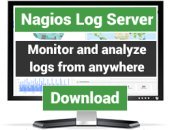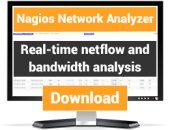Search Exchange
Search All Sites
Nagios Live Webinars
Let our experts show you how Nagios can help your organization.Login
Directory Tree
Nagios V-Shell Featured Popular
Current Version
1.9.1
Last Release Date
2012-02-28
Compatible With
- Nagios 3.x
- Nagios XI
Owner
License
Other
Hits
876147
Version 1.9 has now been overhauled for substantial performance increases. Recommended to use with PHP's APC caching. See INSTALL.txt for more details.
Downloads:
Latest Tarball : Download Nagios V-Shell
View CHANGELOG
Documentation:
Documentation on installing and using V-Shell can be found here. Install documentation is also included in the tarball in INSTALL.txt.
Video Tutorials:
A video tutorial on V-Shell can be found here.
Questions or Feedback:
Post and questions, problems, or feedback at the V-Shell Forum.
Source Code:
Checkout the latest code from github:
V-Shell Source
Older Versions:
1.8
1.7
1.6
1.5
1.9 Upgrade Notes: For users who utilize the XML and JSON export, some information like duration and max check attempts will no longer be calculated.
Upgrading notes for 1.8: V-Shell now handles permissions from the cgi.cfg file to match Nagios Core. Users will not be able to see all hosts and services unless specified in the cgi.cfg.
Latest Tarball : Download Nagios V-Shell
View CHANGELOG
Documentation:
Documentation on installing and using V-Shell can be found here. Install documentation is also included in the tarball in INSTALL.txt.
Video Tutorials:
A video tutorial on V-Shell can be found here.
Questions or Feedback:
Post and questions, problems, or feedback at the V-Shell Forum.
Source Code:
Checkout the latest code from github:
V-Shell Source
Older Versions:
1.8
1.7
1.6
1.5
1.9 Upgrade Notes: For users who utilize the XML and JSON export, some information like duration and max check attempts will no longer be calculated.
Upgrading notes for 1.8: V-Shell now handles permissions from the cgi.cfg file to match Nagios Core. Users will not be able to see all hosts and services unless specified in the cgi.cfg.
Reviews (2)
bylonlone, February 5, 2014
First of all, create software. It was perfect for what we were trying to do, but in doing so, I found a bug. When you associate a user to a specific service instead of all services (by associating it with a host), the first service is dropped off the list. In data/NagiosUser.php in the build_authorized_objects function, services section, there are 2 instances where the object's authHosts array is checked for existence. In both cases, the existence is checked and if it does not exist, then you allocate the array, but the data that you've found is never added to that array. The else case needs to be removed and done every time so that all associated services are added.
I use Nagios to monitor my own servers (and clients’ servers and my employers’ servers, too) and I just gave the new Nagios V-Shell a test-run.
I don’t actually care much about the fact that it’s written in PHP and generates valid XHTML. I am rather interested in the fact that it doesn’t use frames. My hopes are that the interface works nicely on BlackBerries and other smartphones. – Yes, there are frontends which were designed with small screens in mind, but they are either too focused on iPhones or Android with heavy use of JavaScript, or lack some important features such as the ability to acknowledge host or service states etc.
I have yet to test the V-Shell with multiple users, or other users than “nagiosadminâ€â€¦ but this is the bottom line for today:
* Installation is very easy and straight forward
* V-Shell works fairly well on the BlackBerry – slow, but easy to use and intuitive; the views and controls are very close to the original Nagios Core web interface
* Two things weren’t working well in the beginning, but I managed to fix them…
Host icons
I use host icons. They’re mainly just pleasing to the eye in the HTML parts of the web interface, but very useful when you look at the status map. I maintain my own set of icon files in the Nagios Core web interface, but unfortunately the V-Shell doesn’t automatically link the host icons to that location (whereas it relies on the Core interface for service and host commands). My solution is:
1. Remove the logos that shipped with V-Shell: rm -rf /usr/local/vshell/views/images/logos
2. Create a symbolic link to the Core logos folder: cd /usr/local/vshell/views/images ; ln -s /usr/local/nagios/share/images/logos
3. Append the following lines in the vshell_apache.conf files right before the line that says
### for the logos
Options +FollowSymLinks
I also made NagiosGrapher work with V-Shell. Read the rest of the story here: http://ten-fingers-and-a-brain.com/2011/02/trying-out-the-nagios-v-shell/
I don’t actually care much about the fact that it’s written in PHP and generates valid XHTML. I am rather interested in the fact that it doesn’t use frames. My hopes are that the interface works nicely on BlackBerries and other smartphones. – Yes, there are frontends which were designed with small screens in mind, but they are either too focused on iPhones or Android with heavy use of JavaScript, or lack some important features such as the ability to acknowledge host or service states etc.
I have yet to test the V-Shell with multiple users, or other users than “nagiosadminâ€â€¦ but this is the bottom line for today:
* Installation is very easy and straight forward
* V-Shell works fairly well on the BlackBerry – slow, but easy to use and intuitive; the views and controls are very close to the original Nagios Core web interface
* Two things weren’t working well in the beginning, but I managed to fix them…
Host icons
I use host icons. They’re mainly just pleasing to the eye in the HTML parts of the web interface, but very useful when you look at the status map. I maintain my own set of icon files in the Nagios Core web interface, but unfortunately the V-Shell doesn’t automatically link the host icons to that location (whereas it relies on the Core interface for service and host commands). My solution is:
1. Remove the logos that shipped with V-Shell: rm -rf /usr/local/vshell/views/images/logos
2. Create a symbolic link to the Core logos folder: cd /usr/local/vshell/views/images ; ln -s /usr/local/nagios/share/images/logos
3. Append the following lines in the vshell_apache.conf files right before the line that says
### for the logos
Options +FollowSymLinks
I also made NagiosGrapher work with V-Shell. Read the rest of the story here: http://ten-fingers-and-a-brain.com/2011/02/trying-out-the-nagios-v-shell/


 New Listings
New Listings


